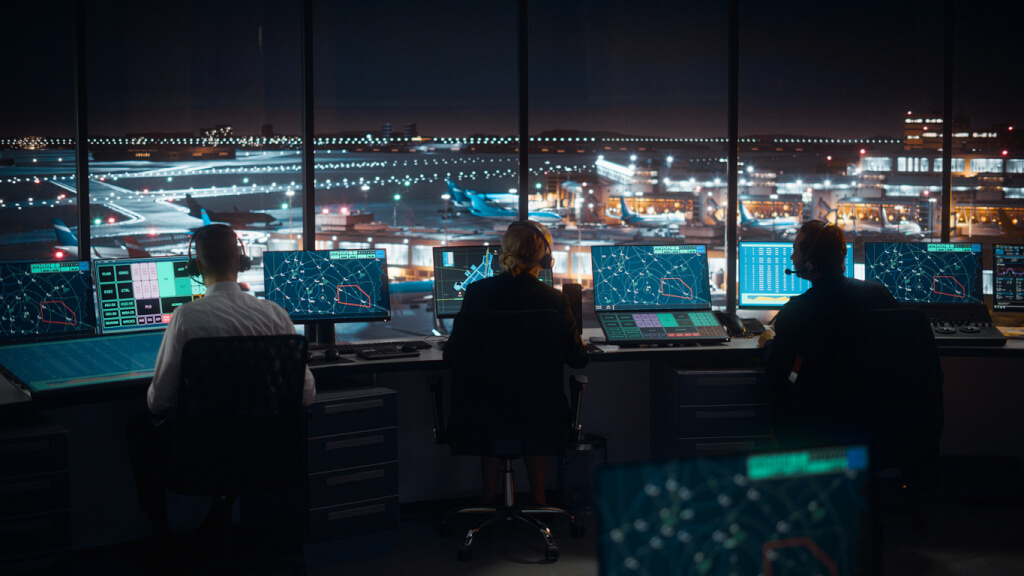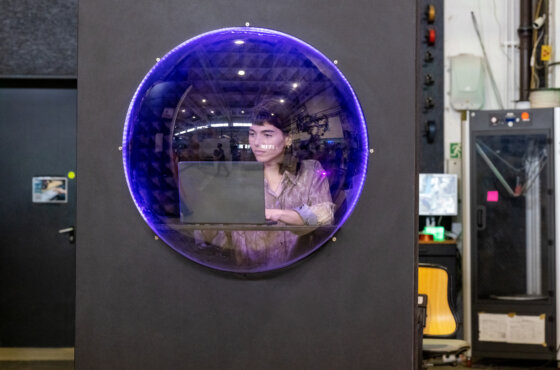Personal experience: what it's like to work as an air traffic controller at the busiest airport in the world
In 2019, air traffic controllers at Atlanta's Hartsfield-Jackson International Airport, the busiest airport in the world, made 909 takeoffs and landings. The 431 airport controllers are responsible for the safety of hundreds of millions of passengers aboard these planes. Insider.

Photo: IStock
Air traffic controllers have to contend with the weather, tight schedules and the knowledge that any mistake they make could cause a ripple effect of delays across the country.
Before the pandemic, in February 2020, Business Insider went to the highest control tower in America to see how training, technology and hard work make this job possible.
After the visit of journalists, the tower was closed to all visitors and introduced the requirement of social distancing and the wearing of masks. The airport only handled 60% of air traffic last year, with 1500 takeoffs and landings a day.
At an altitude of 120 meters above Hartsfield Airport in Atlanta, air traffic controllers watch the skies of the world's busiest airport and issue commands to pilots.
“Okay, Delta 2452, continue. Juliet and Mike de Lima. Charlie, watch the tower, 123.85. Delta 393, Atlanta land runway 27R, stay close to taxiway Dixie,” air traffic controller Stearns can be heard issuing commands.
Air traffic controllers make 2600 landings and departures per day in all weathers.
On the subject: Alaska Airlines has started a ticket sale for the fall: a one-way flight will cost $ 39, but you need to hurry with booking
You can go upstairs, look out the window and see nothing at all, but there will still be traffic at the airport.
“It's a real domino effect. If something goes wrong in Atlanta or there are major delays, it will disrupt air travel across the country and in some parts of the world,” says air traffic controller Caparas.
Back in February, before COVID was called a pandemic, reporters took to the country's tallest control tower to see what it really takes to become an air traffic controller. Hartsfield-Jackson Atlanta International Airport has five runways. The airport requires a constantly changing staff of 58 air traffic controllers to keep the airport running. Before the pandemic, they flew 909 takeoffs and landings every year.
These controllers are responsible for any aircraft in Atlanta Hartsfield airspace, 8 miles away. As soon as an aircraft enters the Atlanta area, air traffic controllers are responsible for communicating with the pilots by radio. They guide pilots in the air through safe landing corridors and pilots on the ground through runways.
“Efficiency, efficiency, efficiency,” Caparas says. — There are many dynamic solutions in this work. If a plane comes in to land and has to go around because the approach is unstable, the weather is not favorable, the runway is not visible, you have to be ready to make a decision.”
Becoming a fully qualified controller can require up to five years of classroom, simulator and on-the-job training. But if they do, the average dispatcher in Georgia makes $145 a year. Tower work in Atlanta is one of the most coveted ATC (air traffic control) positions in the United States. Candidates go through a rigorous hiring process that can take anywhere from just under a year to about six to nine months.
Once they have been hired, the air traffic controllers start working on the simulator.
So any new air traffic controller who came here would first do the paperwork and then, after that, come into the simulator room.
The new air traffic controller will run multiple pass-fail scenarios, but will have fewer aircraft in the simulator than in real life.
After that, they will be evaluated. And then if they pass this test, they can go to work in the control towers.
Air traffic always increases in the summer and also in the days before and after the holidays. But whether it's Christmas Eve or just another Tuesday, controllers need to stay focused.
Controllers must remember and control up to 30 aircraft at the same time. This is mind-boggling, especially since research shows that the human brain can only process seven things at a time in short-term memory.
“I had 25 to 30 aircraft on my frequency at the same time. Everyone was preparing for takeoff. But as soon as I said, “Monitor the tower, 123,85,” then they disconnected from my frequency. So, you know, once you have a lot of work. Then, a minute later, everything can disappear,” says Stearns.
The job is so tiring that the FAA only allows air traffic controllers to work two hours before they need to take a break. To facilitate their work, the work of dispatchers in the tower is very specific.
Each runway is designed for either takeoff or landing.
“Like, this controller is just focused on this runway, this particular runway, and this particular runway,” Stearns says, pointing to his colleague.
The controller who gives the aircraft clearance to take off or land is called the local controller. There are two or three of them in the tower at once.
“This gentleman works with the so-called local five, and the local five currently handles all the arriving planes from the east,” Caparas says of his colleague.
There is also a ground controller. This person handles traffic control on the ground, telling planes which runway to taxi to.
“It will be: “Delta 222, runway 8 left, calm wind, you can land.” We pass this on to ground controller. When they come out, “Delta 222, contact ground, 119,2.” They will move to ground control. Ground control will tell them which direction to steer to get to the ramp,” says Caparas.
Dispatchers have universal rules to follow to make sure everyone is safe. First, it's language.
The international language of air traffic control is English. They also have special terminology so that no two words get mixed up.
“The guys from Chicago O'Hare, PDK or Atlanta Tower say the same things. No one deviates from instructions. It’s this consistency that helps us keep communication to a minimum,” says Caparas.
A minimum of conversations is important because every aircraft and every controller uses the same radio frequency.
“And they're all on the same phone, 15 planes here in Atlanta.” says Caparas.
Short calls are not the only way air traffic controllers ensure efficiency. The flight information paper strips help controllers keep track of all the aircraft going through the process. Each is an airplane. It contains data about the flight number, airline, city to which the aircraft departs or arrives, as well as the time of departure or arrival.
“Once the flight plan is generated at the suggested time, it will be printed. This flight, Delta 1904, is an international flight. It goes from Atlanta to Marigot. So, Delta 904, and this plane is a Boeing 757-200. This plane is scheduled to take off at 15:42. When he takes off, he asks to climb to 11 km. So this paper strip, when it's ready, goes into one of the strip holders. So, you will find Delta 904, which is on the echo level nine. They put Echo Nine here and move it to the appropriate side,” explains Richard Jones, air traffic controller.
The dispatcher has four or five such bars active at the same time. This is how they arrange the planes in order of priority.
“The passenger does not see the big picture. The pilot thinks: “I’m sitting here. Why?" The reason it's kept in the sky is because we're trying to get that consistency so we can get maximum efficiency,” Stearns says.
It is very important for the ground controller to ensure good sequencing because it is efficient and the aircraft can continue moving at top speed. And that's what controllers do. And that's their job.
Efficiency means fewer delays. If serious delays occur, it disrupts air traffic throughout the country and in some parts of the world.
In 2018, Hartsfield-Jackson Atlanta International Airport was ranked the top U.S. airport in terms of flight delays with the highest percentage of on-time departures.
But of course, some things are out of their control.
“On clear days like this, work improves. It's a beautiful sunny day and you can see very well. We can move a whole bunch of planes. 132 pieces per hour, I believe this is the maximum speed of our arrival. On a normal day, we try to handle about 120 aircraft per hour,” Caparas says.
Controllers also have to contend with inclement weather. Sometimes planes can't land on the first try, so they have to circle around and re-queue to land.
“You have to be ready to make a decision. How am I going to get this plane back in the air, back to the next air traffic control station so they can resequence them back to our pattern,” Caparas says.
Luckily, some technological advances have made this whole process much easier. Much is now automated.
You may be interested in: top New York news, stories of our immigrants, and helpful tips about life in the Big Apple - read it all on ForumDaily New York.
While controllers can still use physical paper strips, routes are also displayed on monitors and are automatically passed on to the next controller in sequence. Plus, technology means the weather isn't as impactful as it used to be.
“There was a time when your airport was closed due to weather,” Caparas says. “But now, being able to predict when this weather will happen, we don't worry like we used to.” Sometimes we don’t see anything, and then our equipment is all we have,” Caparas says.
ASDE-X, radar and GPS positioning help controllers track the aircraft.
Now controllers can use this technology to actually separate and identify where these aircraft are. Thus, they can use the term "takeoff cleared" even if they can no longer physically see the runway.
“I don't think many airports can handle what we do. It's true,” says Stearns.
Read also on ForumDaily:
Meteor shower and spectacular full moon: what you can see in the sky in August
In Georgia, the embryo can be declared as a dependent on the tax return
Stores in the US start big sales: where to find great deals from Walmart, Best Buy and Target
Subscribe to ForumDaily on Google NewsDo you want more important and interesting news about life in the USA and immigration to America? — support us donate! Also subscribe to our page Facebook. Select the “Priority in display” option and read us first. Also, don't forget to subscribe to our РєР ° РЅР ° Р »РІ Telegram and Instagram- there is a lot of interesting things there. And join thousands of readers ForumDaily New York — there you will find a lot of interesting and positive information about life in the metropolis.











